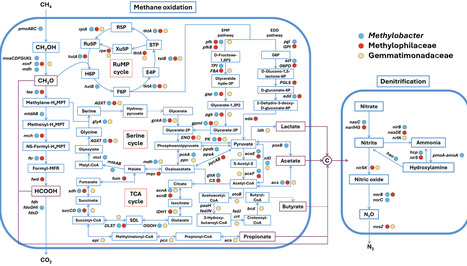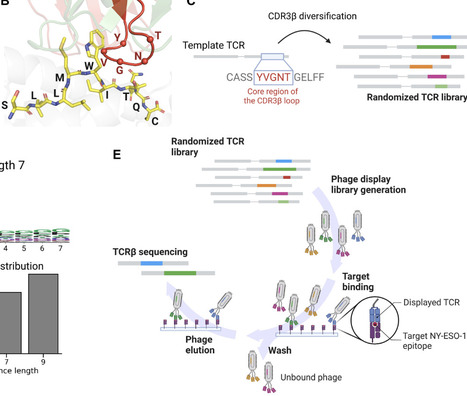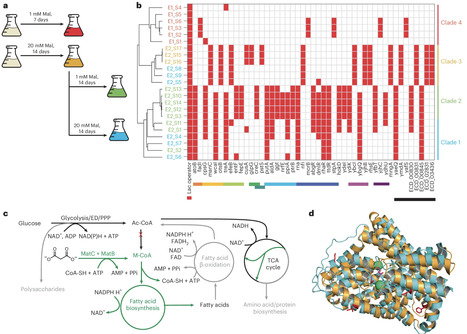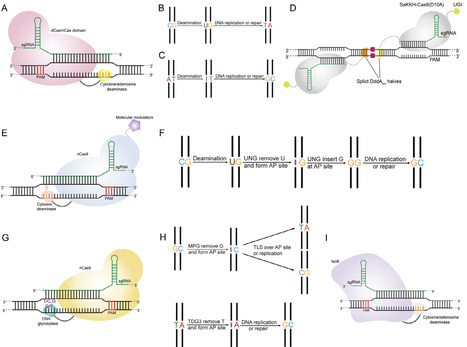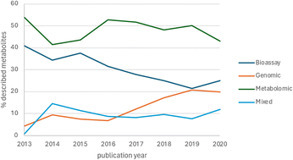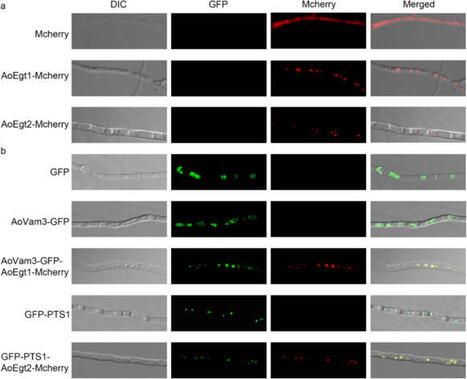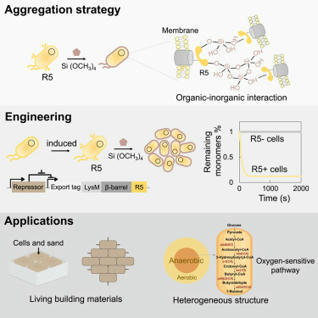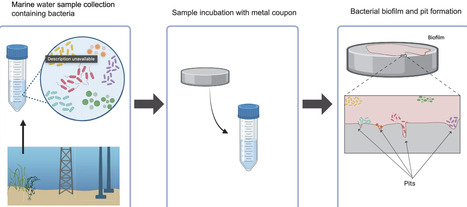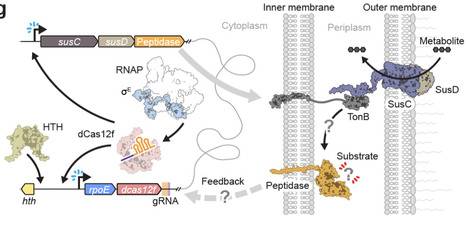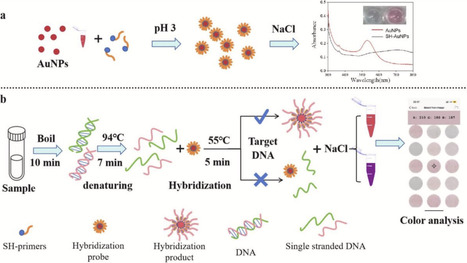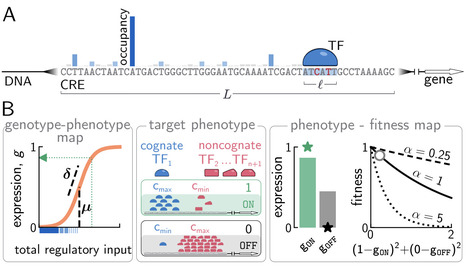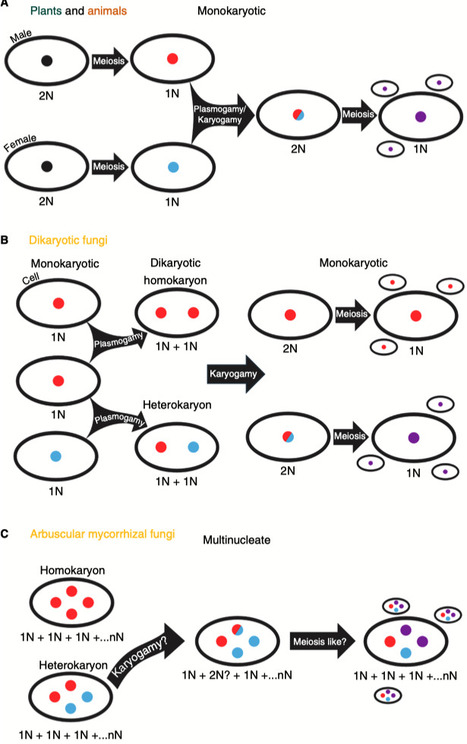 Your new post is loading...

|
Scooped by
?
Today, 7:29 PM
|
The impact of anaerobic oxidation of methane (AOM) coupled with denitrification on the emission of the denitrification intermediate N2O remains poorly understood. Here, we investigated the influence of AOM coupled with nitrate and nitrite reduction on soil N2O emissions and the associated microbial interactions. We show that AOM coupled with denitrification markedly reduces soil N2O emissions, with the type I methanotroph Methylobacter species collaborating with the Methylophilaceae and Gemmatimonadaceae families to perform key roles. The suppression of N2O emissions by AOM primarily stems from its role in supplying electrons and carbon sources, fueling complete denitrification by associated bacteria. In addition, we uncovered distinct microbial interaction strategies for AOM-coupled nitrate and nitrite reduction. While nitrite reduction necessitates both bacterial cooperation and extracellular electron transfer during its initial stages, nitrate reduction predominantly depends on methanotrophic bacteria alone at the outset. These findings advance our understanding of carbon-nitrogen cycle coupling and underscore AOM’s potential to simultaneously mitigate both CH4 and N2O emissions.

|
Scooped by
?
Today, 6:50 PM
|
T cells targeting epitopes in infectious diseases or cancer play a central role in spontaneous and therapy-induced immune responses. Epitope recognition is mediated by the binding of the T cell receptor (TCR), and TCRs recognizing clinically relevant epitopes are promising for T cell–based therapies. Starting from a TCR targeting the cancer-testis antigen NY-ESO-1157–165 epitope, we built large phage display libraries of TCRs with randomized complementary determining region 3 of the β chain. The TCR libraries were panned against NY-ESO-1, which enabled us to collect thousands of epitope-specific TCR sequences. Leveraging these data, we trained a machine learning TCR-epitope interaction predictor and identified several epitope-specific TCRs from TCR repertoires. Cellular assays revealed that the predicted TCRs displayed activity toward NY-ESO-1 and no detectable cross-reactivity. Our work demonstrates how display technologies combined with TCR-epitope interaction predictors can effectively leverage large TCR repertoires for TCR discovery.

|
Scooped by
?
Today, 6:20 PM
|
Cas12j-8 is a compact Cas nuclease discovered from the metagenome of giant bacteriophages, consisting of only 717 amino acids and recognizing the ‘5-TTN-3′ protospacer adjacent motif (PAM) sequence. However, its low gene editing efficiency in mammalian cells limits its application in therapeutic gene editing. To address this limitation, structure-guided mutagenesis is employed to replace key negatively charged residues with arginine, strengthening DNA binding. The resulting quintuple mutant, engineered Cas12j-8 (enCas12j-8), demonstrates robust on-target editing efficiency comparable to LbCas12a while maintaining low off-target effects. Cytosine base editors (CBEs) and adenine base editors (ABEs) are developed using enCas12j-8, achieving up to 29.54-fold C-to-T and 36.57-fold A-to-G conversion efficiency compared with the wild-type at the dominated sites, respectively. Notably, enCas12j-8 enables multiplexed editing of three genomic loci simultaneously via a single crRNA array, achieving efficiencies comparable to single-guide approaches. Additionally, enCas12j-8-ABE facilitates the disruption of splice acceptor sites, effectively inducing exon skipping in the SOD1 gene. This strategy holds potential significance for therapeutic genome modulation. These findings establish enCas12j-8 as a versatile, high-precision tool for genome engineering, combining efficient delivery, multiplexing capability, and compatibility with diverse editing modalities.

|
Scooped by
?
Today, 4:28 PM
|
Heterologous expression of polyketide synthase (PKS) genes in Escherichia coli has enabled the production of various valuable natural and synthetic products. However, the limited availability of malonyl-CoA (M-CoA) in E. coli remains a substantial impediment to high-titer polyketide production. Here we address this limitation by disrupting the native M-CoA biosynthetic pathway and introducing an orthogonal pathway comprising a malonate transporter and M-CoA ligase, enabling efficient M-CoA biosynthesis under malonate supplementation. This approach substantially increases M-CoA levels, enhancing fatty acid and polyketide titers while reducing the promiscuous activity of PKSs toward undesired acyl-CoA substrates. Subsequent adaptive laboratory evolution of these strains provides insights into M-CoA regulation and identifies mutations that further boost M-CoA and polyketide production. This strategy improves E. coli as a host for polyketide biosynthesis and advances understanding of M-CoA metabolism in microbial systems. Malonyl-CoA (M-CoA) is essential for polyketide biosynthesis, but its limited availability constrains production. Here the authors engineer and evolve an orthogonal M-CoA pathway in Escherichia coli to improve M-CoA metabolism, increasing M-CoA levels and polyketide yields.

|
Scooped by
?
Today, 1:25 AM
|
Microplastics and nanoplastics pollution (MNPP) is a major environmental issue due to its small size, long-lasting nature, and potentially harmful impacts on ecosystems and human health. Plastics can be degraded in nature by physical, chemical, and biological processes. Plastic biodegradation is a potential sustainable solution to MNPP, but understanding the fitness of potential plastic-degrading proteins (PPDPs) across environments requires comparative resources. Here, we introduce the Plastic-Degrading Clusters of Orthologous Groups (PDCOGs) database, available at https://phylobone.com/microworld/PDCOG The resource includes 625,616 PPDPs from free-living prokaryotes classified in 51 PDCOGs. The PDCOG database is a robust resource that improves understanding of plastic biodegradation and supports research on global MNPP challenges. Overall, PDPPs represent 3.5% of proteins in prokaryotes and are widely distributed across the Earth, spanning across most prokaryotic species and environments. Nearly all prokaryotic species (>95%) have the potential to biodegrade at least one polymer type.

|
Scooped by
?
Today, 1:06 AM
|
Base editing technology is a novel gene-editing approach derived from the CRISPR/Cas9 system, enabling precise and efficient base conversion. Due to operational simplicity, strong target specificity, high editing efficiency, and minimal editing byproducts, base editing has been widely applied in gene therapy, crop breeding, construction of model organisms, and microbial metabolic engineering. In this review, we systematically summarize the development history and recent advancements of several major base editors, including cytosine base editors (CBEs), adenine base editors (ABEs), CRISPR-free base editors, C-to-G base editors (CGBEs), glycosylase base editors (GBEs), and IscB-derived base editors. Furthermore, we comprehensively summarize optimization strategies for base editors and its application in constructing efficient industrial microorganism, such as Bacillus subtilis, Corynebacterium glutamicum, Saccharomyces cerevisiae, Yarrowia lipolytica, and Aspergillus niger. This review aims to facilitate the broader application of base editing technologies in synthetic biology and accelerate their translational potential.

|
Scooped by
?
Today, 12:57 AM
|
The CRISPR activation (CRISPRa) transcriptional system has become a powerful synthetic biology tool for the regulation of endogenous gene expression, allowing for precise fine-tuning of target genes through the simple modification of sgRNA sequences. In this study, we demonstrate that sgRNAs can be effectively expressed using the T7 transcription system. The insertion of tRNA sequences between PT7 and sgRNAs significantly enhances the efficiency of transcriptional activation. Furthermore, the design of PT7-tRNA-sgRNA arrays facilitates the multiplexed activation of genes. sgRNA expression was regulated by the Tet-on induction system, split-T7 system, and RNA cleavage processing by HH-HDV, resulting in the creation of a Boolean logic gene circuit capable of performing both AND and OR logic operations. Finally, we developed a UPR self-responsive system by utilizing endogenous promoters that are responsive to UPR signals to control the expression of T7 RNAP. This system dynamically regulates the expression of the endogenous HAC1 transcription factor, thus enhancing the secretion of heterologous proteins. The findings from this study highlight the potential of utilizing the T7 transcription system for the construction of genetic circuits, providing a practical toolkit for gene regulation in the industrial Komagataella phaffii strain.

|
Scooped by
?
Today, 12:38 AM
|
In this review, we analyzed the scientific literature of the period 2013–2023 that reported novel specialized metabolites from the Actinomycetes, one of the most prolific producers of natural products. The discovered metabolites were categorized on the basis of their chemical originality into two groups: variants of known molecules, or original metabolites. In addition, we subdivided the approaches used to discover these metabolites into four categories: bioassay-based screening, genome mining, metabolome mining, or combinations thereof. We present selected examples of the different approaches used and the resulting original metabolites. Finally, we measure the overall trends of discovery in terms of approaches, of the frequency of original metabolites and of the major biosynthetic classes that have been described. Overall, our analysis indicates that new metabolites continue to be discovered from Actinomycetes at a relatively constant rate and that the frequency of original metabolites seems to be approach-independent and relatively constant within the analyzed time period.

|
Scooped by
?
June 10, 11:26 PM
|
Ergothioneine (EGT) is a rare amino acid with potent antioxidant and anti-inflammatory properties, with a wide range of applications in food, cosmetics, and medicine. In the present study, Aspergillus oryzae, a common edible fungus, was engineered as an optimal host for EGT production. Moreover, two endogenous genes involved in EGT biosynthesis were characterized. The homolog AoEgt1 was shown to be localized in the vacuoles, whereas the homolog AoEgt2 was found in the peroxisomes. Overexpression of EGT biosynthetic genes from different organisms enhanced EGT production, yielding 15.17 mg EGT/g of dry weight. Using glucose as the carbon source and supplementing methionine (Met) as a precursor further increased EGT production to 20.03 mg EGT/g of dry weight, constituting an eight-fold increase compared to the wild-type strain. This study discusses the successful construction of a high-yielding A. oryzae strain for EGT biosynthesis, providing a novel strategy for efficient EGT synthesis.

|
Scooped by
?
June 10, 11:16 PM
|
Acetogens are anaerobic bacteria of special interest in fighting environmental and economic impacts caused by massive carbon emissions that pollute our Earth’s atmosphere. These microbes have the unique ability to convert carbon monoxide, carbon dioxide, or methanol into value-added bioproducts. The gas fermentation technology is already at industrial scale and is making use of special acetogens able to produce ethanol natively. Here, we propose a methanol-based bioconversion process using anaerobic methylotrophic acetogens (Eubacterium limosum or Eubacterium callanderi) to produce natively only butyrate or butanol, if genetically modified. Therefore, we depict the crucial fermentation parameters and explain the underlying metabolic pathways to steer these biocatalysts towards sole butyrate production. Additionally, the available genetic toolkits are outlined, and the insights gained via system biology approaches are presented. The concept of the suggested bioprocess is only sustainable if green methanol is used as one-carbon feedstock. The use of black or gray methanol would undoubtedly counteract all efforts towards net-zero CO2 emissions. To meet tightening climate targets and environmental, social, and governance commitments, stakeholders must evaluate a spectrum of low‑carbon technologies. The data presented here indicate that biotechnological fermentations can reduce emissions while remaining commercially competitive, and therefore warrant serious consideration for future industrial deployment and investment.

|
Scooped by
?
June 10, 10:41 PM
|
Programmable cell aggregation offers valuable insights into the natural development of synthetic multicellular systems and enables precise control over spatial organization and material structuring. Previous efforts have focused on modifying cells with designed organic-based adhesive modules and assembling cells into defined patterns. Here, we present a different approach to guide cell assembly by tuning the organic-inorganic interactions. Our method involves engineering cells to express a silicifying peptide on their surfaces, which promotes silica deposition on the cell walls. This peptide simultaneously binds to the silica synthesized on adjacent cells, triggering cell clustering. The engineered cells exhibit rapid aggregation, with approximately 95% of cells assembling within 15 min. We further show that this capability can facilitate materials assembly and chemical production. Our biosilicification-based approach offers novel insights into natural multicellularity mechanisms and holds potential for applications in biomanufacturing and materials engineering.

|
Scooped by
?
June 10, 4:03 PM
|
The Fungal Kingdom is vast, spanning two to five million, or even more, fungal species. Only a relatively small fraction has been isolated and named, and an even smaller number have been subjected to genetic, molecular, and genomic studies. This special issue of Current Biology celebrates the diversity of the fungal kingdom, confronts some of the serious challenges presented by fungi, and highlights the wealth of opportunities they present for biological discovery.

|
Scooped by
?
June 10, 3:40 PM
|
Arbuscular mycorrhizal (AM) fungi are ancient plant mutualists that are ubiquitous across terrestrial ecosystems. These fungi are unique among most eukaryotes because they form multinucleate, open-pipe mycelial networks, where nutrients, organelles, and chemical signals move bidirectionally across a continuous cytoplasm. AMF play a crucial role in ecosystem functioning by supporting plant growth, mediating ecosystem diversity, and contributing to carbon cycling. It is estimated that plant communities allocate ∼3.93 Gt CO2e to AMF every year, much of which is stored as lipids inside the fungal network. Despite their ecological significance, the cellular biology of AMF remains underexplored. Here, we synthesise the current knowledge on AMF cellular structure and organization. We examine AMF development at different biological levels — the hypha and its content, hyphal networks and AMF spores — and explore key cellular dynamics. This includes cell wall composition, cytoplasmic contents, nuclear and lipid organisation and dynamics, network architecture, and connectivity. We highlight how their unique cellular arrangement enables complex cytoplasmic flow and nutrient exchange processes across their open-pipe mycelial networks. We discuss how both established and novel techniques, including microscopy, culturing, and high-throughput image analysis, are helping to resolve previously unknown aspects of AMF biology. By comparing these insights with established knowledge in other, well-studied filamentous fungi, we identify critical knowledge gaps and propose questions for future research to further our understanding of fundamental AMF cell biology and its contributions to ecosystem health.
|

|
Scooped by
?
Today, 7:10 PM
|
Plants make complex and potent therapeutic molecules, but sourcing these molecules from natural producers or through chemical synthesis is difficult, which limits their use in the clinic. A prominent example is the anti-cancer therapeutic paclitaxel (sold under the brand name Taxol), which is derived from yew trees (Taxus species). Identifying the full paclitaxel biosynthetic pathway would enable heterologous production of the drug, but this has yet to be achieved despite half a century of research. Within Taxus’ large, enzyme-rich genome, we suspected that the paclitaxel pathway would be difficult to resolve using conventional RNA-sequencing and co-expression analyses. Here, to improve the resolution of transcriptional analysis for pathway identification, we developed a strategy we term multiplexed perturbation × single nuclei (mpXsn) to transcriptionally profile cell states spanning tissues, cell types, developmental stages and elicitation conditions. Our data show that paclitaxel biosynthetic genes segregate into distinct expression modules that suggest consecutive subpathways. These modules resolved seven new genes, allowing a de novo 17-gene biosynthesis and isolation of baccatin III, the industrial precursor to Taxol, in Nicotiana benthamiana leaves, at levels comparable with the natural abundance in Taxus needles. Notably, we found that a nuclear transport factor 2 (NTF2)-like protein, FoTO1, is crucial for promoting the formation of the desired product during the first oxidation, resolving a long-standing bottleneck in paclitaxel pathway reconstitution. Together with a new β-phenylalanine-CoA ligase, the eight genes discovered here enable the de novo biosynthesis of 3’-N-debenzoyl-2’-deoxypaclitaxel. More broadly, we establish a generalizable approach to efficiently scale the power of co-expression analysis to match the complexity of large, uncharacterized genomes, facilitating the discovery of high-value gene sets. An approach that combines single-nucleus RNA sequencing and multiplexed perturbation identifies genes that enable the biosynthesis of direct precursors of the anti-cancer drug Taxol, whose current production involves a laborious extraction process from yew trees.

|
Scooped by
?
Today, 6:37 PM
|
Phage therapy is emerging as a promising strategy against the growing threat of antimicrobial resistance, yet phage and bacteria are incredibly diverse and idiosyncratic in their interactions with one another. Clinical applications of phage therapy often rely on a process of manually screening collections of naturally occurring phages for activity against a specific clinical isolate of bacteria, a labor-intensive task that is not guaranteed to yield a phage with optimal activity against a particular isolate. Herein, we review recent advances in artificial intelligence (AI) approaches that are advancing the study of phage-host interactions in ways that might enable the design of more effective phage therapeutics. In light of concurrent advances in synthetic biology enabling rapid genetic manipulation of phages, we envision how these AI-derived insights could inform the genetic optimization of the next generation of synthetic phages.

|
Scooped by
?
Today, 6:04 PM
|
Steel corrosion is an extensive problem worldwide, substantially impacting marine infrastructures. In this study, the influence of steel on bacterial succession and corrosion was investigated by culturing marine water samples with and without steel coupons for 14 days. Compared to abiotic controls, oxygen levels were rapidly depleted in biotic cultures. Fe levels increased in controls compared to biotic cultures, potentially due to anoxic conditions and the incorporation of Fe in the biofilm. Proteobacteria dominated the initial cultures, but over 14 days the number of phylogenetic groups decreased overall in abundance. Taxons that increased in abundance included Clostridiaceae, Fusobacteriaceae, Flavobacteriaceae and Prolixibacteraceae, some members of which can utilize Fe. While initially in low abundance, Arcobacteraceae, Pseudoalteromonadaceae, Rhodobacteraceae and Rhizobiaceae numbers increased over time. Sites 1 and 2 cultures displayed localised deep pitting corrosion on coupon surfaces, consistent with microbial action, with an increase in Bacteroidetes, suggesting this phylum facilitates corrosion. In contrast, Site 3 cultures displayed uniform, superficial corrosion, with Clostridiaceae being the dominating family by Day 14, suggesting corrosion inhibition through biofilm formation. By identifying bacteria associated with corrosion, targeted approaches to corrosion reduction may be developed through identifying significant metabolic pathways by transcriptomics and the application of metabolic inhibitors.

|
Scooped by
?
Today, 1:37 AM
|
Bacterial transcription initiation is a tightly regulated process that canonically relies on sequence-specific promoter recognition by dedicated sigma (σ) factors, leading to functional DNA engagement by RNA polymerase (RNAP). Although the seven σ factors in E. coli have been extensively characterized, Bacteroidetes species encode dozens of specialized, extracytoplasmic function σ factors (σE) whose precise roles are unknown, pointing to additional layers of regulatory potential. Here we uncover an unprecedented mechanism of RNA-guided gene activation involving the coordinated action of σE factor in complex with nuclease-dead Cas12f (dCas12f). We screened a large set of genetically-linked dCas12f and σE homologs in E. coli using RIP-seq and ChIP-seq experiments, revealing systems that exhibited robust guide RNA enrichment and DNA target binding with a minimal 5ʹ-G target-adjacent motif (TAM). Recruitment of σE was dependent on dCas12f and guide RNA (gRNA), suggesting direct protein-protein interactions, and co-expression experiments demonstrated that the dCas12f-gRNA-σE ternary complex was competent for programmable recruitment of the RNAP holoenzyme. Remarkably, dCas12f-RNA-σE complexes drove potent gene expression in the absence of any requisite promoter motifs, with de novo transcription start sites defined exclusively by the relative distance from the dCas12f-mediated R-loop. Our findings highlight a new paradigm of RNA-guided transcription (RGT) that embodies natural features reminiscent of CRISPRa technology developed by humans.

|
Scooped by
?
Today, 1:11 AM
|
Total bacterial counts (TBC) and coliforms bacteria have been used as the index of microbial quality and fecal contamination for foods, the detection of them is involved in microbiological criteria of most countries to guarantee food safety. In this study, a gold nanoparticle (AuNPs) based colorimetric assay for rapid detection of TBC and coliform bacteria was developed by using the molecular hybridization approach. Thiol modified primers SH-27F and SH-lacZF were designed and conjugated with AuNPs, which was acted as both hybridization probe and signal probe, and salt induced aggregation of AuNPs was indicator of the hybridization and detection. Escherichia coli was studied as model strain in this study. The result showed that under the optimal conditions, the limit of detection for TBC and coliforms bacteria were 102 CFU/mL and 101 CFU/mL by visual detection, and 101 CFU/mL by UV–vis spectrum analysis, a smart phone application named ColorPicker was used for the quantitative analysis of the colorimetric assay. The color signal had good linear relationship of E. coli concentration in the range of 101–104 CFU/mL. The detection is rapid, simple and sensitive, without the needing of culture enrichment and precious equipment, has good application potential for the on-site detection of TBC and coliforms bacteria. In addition, the proposed strategy provides a direction for the design of highly sensitive colorimetric signal probes for other pathogenic microorganisms.

|
Scooped by
?
Today, 1:02 AM
|
Excessive sugar consumption is associated with metabolic disorders such as obesity and diabetes, prompting the search for healthier alternatives. Sweet-tasting proteins offer high sweetness, safety, and low caloric content, making them promising sugar substitutes. However, their application is hindered by limited natural abundance and challenging extraction processes from plant sources. In this study, the microorganism-based sweet-tasting protein was explored. Brazzein was first verified as an expressible protein for production using the Komagataella phaffii expression system. Through the evaluation of promoters and signal peptides, the PAOX1→SP0030→PbBRZ→Tdas1 expression cassette was identified as optimal for brazzein production. Via the optimization of brazzein gene copy number and the modulation of protein translation, folding, and degradation processes, brazzein production was further improved to 113.24 and 166.54 mg/L, respectively. By performing fed-batch fermentation in a 5 L bioreactor, the engineered strain produced brazzein at a titer of 639.11 mg/L. This is the highest level for microbial brazzein production. These findings highlight the effectiveness of our strain optimization strategies and provide a foundation for the industrial application of sweet-tasting proteins.

|
Scooped by
?
Today, 12:48 AM
|
Cupriavidus necator is a promising bacterium for producing polyhydroxybutyrate (PHB), a biodegradable bioplastic. However, the cell growth is restricted due to a lack of glucose transporters and low glucokinase activity. To address this limitation, we first developed comprehensive genetic toolkits to express sfGFP as a proof-of-concept in C. necator. A plasmid-driven T7 RNA polymerase (PDT7) system under the J23109 promoter achieved a 10-fold increase in fluorescence compared to strains without PDT7. However, PDT7 imposed a metabolic burden at higher expression levels and remained less effective than the constitutive Trc promoter, which consistently exhibited the highest transcriptional strength. Based on its robust and balanced performance, the Trc promoter was optimized to drive expression of galP (galactose permease) and glk (glucokinase) genes from Escherichia coli, (annotated as Tgg-H16), enabling enhanced glucose uptake, biomass and PHB biosynthesis. Further enhancement was achieved by supplementing a mixed carbon source, that is, 10 g/L glucose and 10 g/L fructose, which shortened the lag phase and supported higher PHB yields. Finally, a stepwise feeding strategy in fermentation boosted PHB production to 30.9 g/L. Rewiring carbon flux in C. necator through genetic circuit design demonstrates the feasibility of improving carbon uptake, while integration with tailored cultivation strategies enables upcycling sustainable PHB production.

|
Scooped by
?
June 10, 11:51 PM
|
Cis-regulatory elements (CREs), such as enhancers and promoters, control gene expression by binding regulatory proteins. In contrast to their bacterial counterparts, eukaryotic CREs typically bind transcription factors with short recognition motifs across multiple functional yet often weak binding sites. The evolutionary origin of this genetic architecture remains unclear. Here we study adaptive evolution of entire CREs under selection for controllable gene expression. In a biophysical toy model that recapitulates the essential nonlinearities of eukaryotic regulation, a regulatory phenotype requires a gene to be active when its CRE binds cognate TFs, yet inactive in the presence of noncognate TFs that can cause deleterious crosstalk. We explore CRE evolutionary outcomes utilizing "optimize-to-adapt" approach suggested by the theory presented in a companion paper. In this approach, CRE evolution is simulated explicitly at the sequence level, while the parameters of the biophysical model itself -- i.e., the properties of the replicated genotype-phenotype map -- are numerically optimized for CRE evolvability. In the optimal regime, selection navigates the tradeoff between slowly evolving strong and long binding sites (which guarantee low crosstalk), and rapidly evolving multiple short and weak binding sites (which necessitate diffuse selection against excessive noncognate binding across the entire CRE). When we further explore various scenarios for cooperative regulation, we find that the optimal regime predicts a diversity of strong and weak, yet always short, binding sites and favors "synergistic activation" of transcription, as reported empirically for eukaryotes. These results showcase how information theory can link evolutionary dynamics with biophysical constraints to rationalize -- and possibly even predict -- optimal regulatory architectures.

|
Scooped by
?
June 10, 11:24 PM
|
Accumulating evidence indicates that microorganisms respond to the ubiquitous plastic pollution by evolving plastic-degrading enzymes. However, the functional diversity of these enzymes and their distribution across the ocean, including the deep sea, remain poorly understood. By integrating bioinformatics and artificial intelligence-based structure prediction, we developed a structure- and function–informed algorithm to computationally distinguish functional polyethylene terephthalate-degrading enzymes (PETases) from variants lacking PETase activity (pseudo-PETase), either due to alternative substrate specificity or pseudogene origin. Through in vitro functional screening and in vivo microcosm experiments, we verified that this algorithm identified a high-confidence, searchable sequence motif for functional PETases capable of degrading PET. Metagenomic analysis of 415 ocean samples revealed 23 PETase variants, detected in nearly 80% of the samples. These PETases mainly occur between 1000 and 2000 m deep and at the surface in regions with high plastic pollution. Metatranscriptomic analysis further identified PETase variants that were actively transcribed by marine microorganisms. In contrast to their terrestrial counterparts—where PETases are taxonomically diverse—those in marine ecosystems were predominantly encoded and transcribed by members of the Pseudomonadales order. Our study underscores the widespread distribution of PETase-containing bacteria across carbon-limited marine ecosystems, identifying and distinguishing the PETase motif that underpins the functionality of these specialised cutinases.

|
Scooped by
?
June 10, 11:09 PM
|
Synthetic biology approaches such as whole-cell biosensing and ‘sense-and-respond’ therapeutics aim to enlist the vast sensing repertoire of gut microbes to drive cutting-edge clinical and research applications. However, well-characterised circuit components that sense health- and disease-relevant conditions within the gut remain limited. Here, we extend the flexibility and power of a biosensor screening platform using bacterial memory circuits. We construct libraries of sensory components sourced from diverse gut bacteria using a bespoke two-component system identification and cloning pipeline. Tagging unique strains using a hypervariable DNA barcode enables parallel tracking of thousands of unique clones, corresponding to ~150 putative biosensors, in a single experiment. Evaluating sensor activity and performance heterogeneity across various in vitro and in vivo conditions using mouse models, we identify several biosensors of interest. Validated hits include biosensors with relevance for autonomous control of synthetic functions within the mammalian gut and for non-invasive monitoring of inflammatory disease using faecal sampling. This approach will promote rapid biosensor engineering to advance the development of synthetic biology tools for deployment within complex environments.

|
Scooped by
?
June 10, 10:35 PM
|
Biofilm formation is the most effective pathway for electron transfer to anodes in bioelectrochemical systems. However, the mechanisms triggering biofilm formation under anoxic conditions, as well as the architectural and compositional factors that positively influence current generation, are not well understood. Recent findings have shown that riboflavin can function similarly to a quorum sensing molecule in the γ-proteobacterium Shewanella oneidensis. Enhanced biofilm formation induced by riboflavin correlates with increased current densities. Only a limited number of candidate proteins were found to have altered concentrations due to this quorum sensing mechanism. This study demonstrates that the catalytic functions of the UDP-N-acetylglucosamine C4 epimerase WbpP and UDP-N-acetyl-D-glucosamine 6-dehydrogenase WbpA affect biofilm formation and lead to increased current density. Using optical coherence tomography, we found that the expression of each protein individually causes specific, quantifiable changes in biofilm architecture, including biovolume, height, and porosity. However, the current density did not significantly differ when these proteins were expressed alone compared to the control. In contrast, co-expression of WbpP and WbpA resulted in a doubling of current density, closely resembling the increases observed with riboflavin-mediated quorum sensing. We hypothesize that riboflavin-based quorum sensing may lead, through several intermediary steps, to the overproduction of WbpA and WbpP, resulting in better attachment to graphite anodes and thus higher current densities.

|
Scooped by
?
June 10, 3:52 PM
|
The fungal kingdom is a diverse eukaryotic clade largely composed of microbial organisms. Comprised of indispensable plant symbionts, major environmental decomposers, and important plant and animal pathogens, fungi directly shape the biological world. Advancements in genomics have increased our understanding of fungal genomic variation, the mechanisms that generate it, and the association of genomic plasticity with fungal ecological lifestyles and adaptation. In this review, we discuss the patterns and mechanisms underlying fungal genomic plasticity, juxtaposing them, where known, with patterns and mechanisms observed in plants and animals. We begin by describing the plasticity of fungal genomes, which ranges from large-scale variation in size and ploidy to the physical or temporal compartmentalization of evolutionary rates. We summarize notable patterns of genomic plasticity that have evolved independently across the fungal kingdom, including but not limited to accessory chromosomes, two-speed genomes, and hypermutation; some of these patterns are unique to fungi and largely absent from animals or plants. Strikingly, certain patterns are associated with specific ecological lifestyles, raising the hypothesis that the plasticity of fungal genomes facilitates these lifestyles. We then describe the wide variety of mechanisms that contribute to fungal genome plasticity, including sexual reproduction, transposable-element mobilization, and aneuploidy. Some mechanisms appear to be lineage-specific (for example, Starship transposable elements and repeat-induced point mutations), whereas others are more broadly distributed (parasexual and sexual reproduction). We conclude by discussing how a more balanced sampling of fungal genomes, including population genomic data, will lead to greater insights into fungal genome plasticity and its origins.
|



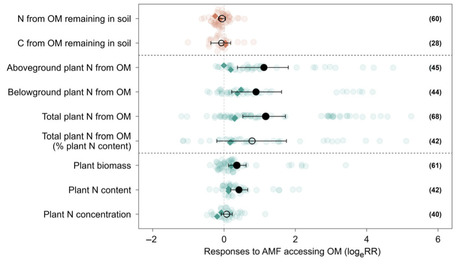


 Your new post is loading...
Your new post is loading...
